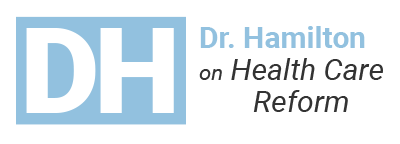Reforming America’s complex health care system is filled with controversy. Out of 333 million people, 216 million have private insurance, 73 million have Medicaid, CHIPS, or other government programs. 44 million have Medicare. Our system is unequaled in quality and availability, but it is far too costly. It will only become worse, unless we provide practical solutions in a timely manner.
For us to succeed, the primary focus must be the patient. An all-encompassing program that loses this focus will ultimately fail. We must preserve availability, quality, and choices, while controlling cost.
Government, the hospital industry, the insurance industry, pharmaceuticals, the nursing profession, and medical equipment manufacturers will obviously all play major roles. But as past-AMA President Daniel (Stormy) Johnson so aptly puts it, we must “Put the patient in the driver’s seat, with the doctor riding shotgun”. The wellbeing of our patients and the future of the medical profession are inseparable.
Fortunately, many groups, think tanks and individuals have been studying the system for years, but many of their excellent ideas are not widely understood. The Health Policy Consensus Group has recently published “The Health Care Choices Proposal: Policy Recommendations for Congress”. Some of their recommendations have already been submitted as new legislation.
This article will summarize and briefly describe these and other proposals. Major Medicare reform will probably be proposed at a later date.
Formula BLOCK GRANTS – The geographical diversity of this country demands that states play a vital role. Federal takeover of individual and small group health insurance has resulted in huge premium increases, insurance company monopolies and duopolies, a very small individual insurance market, and fewer people insured.
Under Section 1332 of the Affordable Care Act, states can apply for federal waivers. However, the application process and the allowable limits for change are so stifling that only a few states have applied. Fewer still have obtained them. The current administration has removed many impediments, but effective modification will require Congressional action.
Federal funds currently going to insurance companies should go to the states as block grants to help low income patients and those with pre-existing conditions obtain their choice of coverage from doctors and facilities.
At lease 50% of grants would help people purchase private insurance. An overlapping 50% would provide coverage for low income people. A portion would assist people with pre-existing conditions. This federal tax money cannot be used to pay for abortions. Recipients of block grant funds, Medicaid or CHIPs could purchase health plans of their choice, including Health Savings Account Plans (HSAs).
HEALTH SAVINGS ACCOUNTS – A Health Savings Account (HSA) is a bank account whose annual contributions can only be used for paying medical expenses, such as out-patient testing and treatment, medication, medical visits, and some items not covered by insurance – but not health insurance premiums. Contributions can be made by an employer, an individual, a relative or even an acquaintance. Contributions, annual roll-over compound interest, and withdrawals are tax free. HSAs must be paired with a qualified high deductible insurance policy, which is much less expensive than low deductible insurance.
HSAs, passed into law in 2003, now cover well over 20 million people. Studies show that HSAs change patients’ behavior and encourage improved patient care through better compliance with outpatient testing, medication, and treatment programs. The resulting decreased hospitalization markedly reduces overall health care cost.
Congress should: allow much larger HSA fund contributions; allow HSAs to fund health insurance for private and Medicaid patients; and modify federal programs to accommodate HSAs. Many, but not all Medicaid patients would become private patients, instead of inundating hospital emergency rooms and receiving expensive treatment for minor illnesses.
PRE-EXISTING CONDITIONS: – Hoover Institute Senior Fellow John Cochrane, has called pre-existing conditions, “The Central Defect of American Health Insurance”. A successful reform plan requires mitigation of this problem.
Between 1994 and 2002, New Jersey required health insurance plans to insure patients with pre-existing conditions (Guaranteed Insurability) thus incurring extra cost for fellow policyholders (Community Rating). Insurance premium costs multiplied 4.4 to 7.1 times. Actuaries cannot predict these added risk pool costs. The Affordable Care Act yielded the same results, even with employer and individual mandates.
The risk pool must be separated to cover high-risk patients and be mitigated by redirecting federal funds previously used to subsidize insurance premiums, combined with funds from non-federal sources. In Alaska, these include: 1) “ceded funds” (insurance companies “cede” a portion of previously paid high premiums to the pool, after the patient’s claims have been transferred to the pool); 2) state assessments on insurers; and (3) state general tax fund contributions.
Eight states have similar, pending or approved mitigation plans. Independent state actuarial estimates show reduced premiums and increased patient enrollment. Larger mitigation programs should increase these benefits. Reduced premiums will reduce federal subsidies and thus be budget neutral.
OTHER INNOVATIONS – Many other ideas deserve consideration.
Health Status Insurance would travel with an employee who changes jobs, even after the employee has developed a new disease during the initial employment. Reciprocal agreements would allow the new employers to pick up the higher cost, allowing employees to change jobs, and not be confined by their present employment.
Association Health Plans would allow small employers to reduce their health insurance cost by spreading insurance risk among a much wider group. These are currently being tested at the state level in many states, but may require measures to minimize fraud, inadequate coverage and other possible shortcomings.
Some health insurance innovations might include: federal reinsurance plans; short term insurance for seriously ill, low income patients; disease-specific insurance; automatic transfer of medical records between plans; health plans that question patients and request certain tests and treatments; expanded HSA plan deductibles and out-of-pocket expense coverage; use of HSAs to pay for medical phone calls, email consults, concierge physician participation, home visits, and chronic disease management.
American free minds will solve these problems and implement practical solutions.
Robert F. Hamilton, M.D., FACS
Godfrey, Illinois
(first published in the Belleville News-Democrat on 3/31/19)





